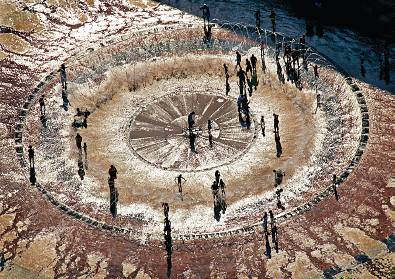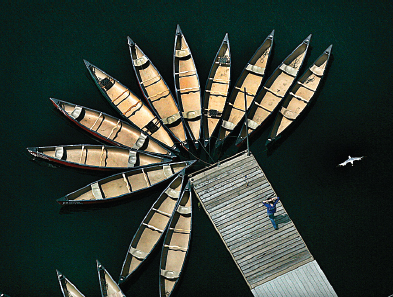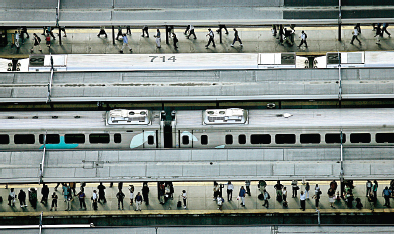About the Photographs that Open Parts 1–4
A Series of Aerial Photographs by David L. Ryan
A long-time staff photographer at the Boston Globe, David L. Ryan is well known for his distinctive aerial photography. His witty and moving images often show familiar scenes from fresh perspectives and reveal beautiful patterns hidden among commonplace, everyday realities. Like a writer, he keeps his audience close in his thoughts as he works, with the goal of sharing his curiosity, knowledge, and enthusiasm with those who see his images. As he puts it, “I’ve been in Boston all my life. I’ve gone around here by boat, helicopter, plane, train, bicycle, and walking. I want to make people say, ‘How did you get that?’” In another parallel with writing, he finds an open-minded, “learning by doing” approach to be beneficial: “I’m still experimenting with it,” he says of his work. “Everything is an experiment.”

Part 1: Fountain and bathers (pages 4–5)
It’s obvious that a photographer must choose a point of view. He or she must literally choose a place to stand and an angle from which to view a scene. So must a writer.
In this image, what effects are created by the photographer’s chosen point of view? What effect does his elevated perspective have on how the scene appears? What is gained and lost by photographing from this distance? What observations do you think the photographer is making about what he is seeing?

Part 2: Rowboats tied to dock (pages 56–57)
If you were to take something you have written and rewrite it from an entirely different point of view, the two versions would likely have different meanings and might accomplish different purposes. You convey meaning and purpose, in part, through your choice of perspective. Similarly, for a photographer, a change in perspective can create a feeling of strangeness, make a point, or offer a commentary. From the air things might look like something else for a second.
In this image, what point or points do you think the photographer is making? Is his focus the season, sport, recreation, equipment, place, person, state of mind, or some other subject? How does his point of view help to convey that meaning?

Part 3: Trains (pages 256–57)
Before a photographer takes a picture, he or she has to decide how much of the scene to include. Will the image be a close-up of a face or an aerial view? Does the image give the viewer specific information about a specific individual or show more general patterns? Writers, too, must make decisions about how much of a topic or a discussion to include and how to define the boundaries of a topic.
What does this photograph include? What does it leave out? What can you tell about the people — either as individuals or as groups — shown in this photo? What does the image communicate that might be less apparent from ordinary photographs taken of people at ground level? How does the image find interest and import in the routine?

Part 4: Flooded baseball fields (pages 370–71)
Photographers and writers are both alert to rhythms and correspondences as well as to patterns and meanings below the surface. Writers can express rhythm by selecting their words, by controlling the length of sentences and paragraphs, and by creating a structure that helps the reader follow an unfolding essay. Ryan makes his work compelling by conveying a sense of rhythm through geometry.
What is the mood of this photograph? What does this image of flooded fields say to you, the viewer? How does it balance ordinary and extraordinary elements against each other?